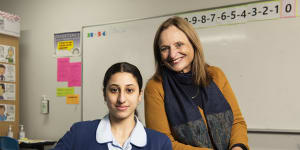The data also shows a move to make advanced or extension mathematics prerequisites in dozens of NSW university courses in 2019 has so far failed to boost stagnating enrolments among both boys and girls.

Cerdon College extension maths student Joyce Eweda and maths coordinator Grace Muscat.Steven Siewert
While cumulative enrolments of the three advanced maths courses offered at HSC level have fallen 12 per cent in 20 years,participation in the easier standard maths courses has risen 15 per cent in the same period.
The percentage of people choosing to do the easiest maths (Standard Mathematics 1),which can be taken as an ATAR or non-ATAR subject,has increased almost 30 per cent since it was introduced in 2014.
Professor of Mathematics Education at the University of NSW Kim Beswick said it was worrying that fewer students were choosing to do higher-level maths because it limited their options for careers in STEM.
“The reasons for it are probably many and complicated,” she said. “There’s research that says that students don’t choose maths because they judge it to be too difficult and that it will take too much of their time in HSC. They also lack confidence in their ability to succeed in maths.
“So they make a calculation that in terms of the time and effort it’s going to take,it’s really just not worth it and they can have a less stressful HSC and get a better ATAR by not doing it.”

Girls are more likely to complete the most popular maths course - the non-calculus Standard Mathematics 2 - accounting for 52 per cent of students.
However,they are far less likely to complete the more difficult maths courses of Advanced Mathematics,Extension Mathematics 1 and Extension Mathematics 2.
In 2021,just 35 per cent of Extension Mathematics 2 and 40 per cent of Extension Mathematics 1 candidates were female.
Despite an increased focus on women’s participation in STEM subjects,girls’ involvement in the two extension maths courses is at the equal lowest proportion in more than 20 years.
Girls’ participation as a proportion of enrolments in the two hardest maths subjects peaked in 2005 when they accounted for 43 per cent of Extension 1 and 40 per cent of Extension 2 students.
Beswick said girls may be less likely than boys to complete higher level maths because they are more likely to believe they will achieve a higher ATAR by focusing on subjects like English and humanities.
Cerdon College Merrylands student Joyce Eweda is among the HSC girls completing higher level maths,doing Advanced Mathematics and Extension 1.
She said she used to find maths boring but developed a love of it when she was placed in an accelerated course in year 9.
“When I started taking an interest in the content we were learning,I guess I found there was a beauty to maths and it was different to all the other subjects,” Joyce said.
Her all-girls school has bucked the trend and gradually increased the number of girls doing Advanced Maths.
Maths coordinator Grace Muscat attributes the change to moving more students into more advanced maths classes in years 9 and 10,where more than half now do the highest level.
“What it has done is reinforce in students that girls can do maths,” she said. “All our maths teachers are qualified maths teachers which doesn’t happen at all schools these days because there is such a shortage. Our students see that extension teachers are female … so they have all these role models before them.”
In 2016,the University of Sydney announced it was making maths a prerequisite for a number of courses from 2019.
“We want to encourage students,particularly female students,to engage with mathematics at a level higher than general[standard] maths,and so lift the marked decline in enrolments across Australia and our declining national performance in the subject on global leagues tables,” it said at the time.
However,the enrolment data since then has not revealed any increase in participation so far.
A NSW Education Standards Authority spokesperson said the new year 7 to 10 syllabus was being designed to be more flexible and better linked to HSC courses to encourage as many people as possible to do advanced and extension courses.
NESA said the previously would be compulsory by 2025.